US Sailors who cruise are different than those who just race. A US pure racing sailor views sailing as a competition between human athletes with the vessel being equipment. A US cruising sailor views the crew as components of the vessel required to make it seaworthy. These views have implications in crew selection and training.
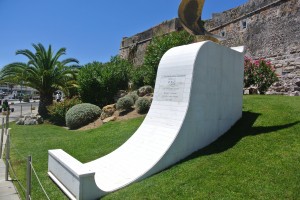 The former allows for selection of athletes who have no sailing experience (but are otherwise fit for a triathlon). These follow without knowledge necessary to form questions. Those who do not venture to ask questions are valued over those who do. Knowledge is shared on a need to know basis because there is concern that selected athletes may take knowledge to competitors. Knowledge of the racing rules isn’t desired because loyalty is valued above the competency gained from study of the rule books. The athletes are replaceable – meaning they can be flicked off (removed from) crews with no damage to the overall goal -which is to win.
The former allows for selection of athletes who have no sailing experience (but are otherwise fit for a triathlon). These follow without knowledge necessary to form questions. Those who do not venture to ask questions are valued over those who do. Knowledge is shared on a need to know basis because there is concern that selected athletes may take knowledge to competitors. Knowledge of the racing rules isn’t desired because loyalty is valued above the competency gained from study of the rule books. The athletes are replaceable – meaning they can be flicked off (removed from) crews with no damage to the overall goal -which is to win.
The later US Sailors, the ones who cruise, are different animals. They must seek knowledge, not just from rule books but from libraries and from scuttlebutt. They must question everything in order to gain competency and make the vessel seaworthy. This is because, on any given day, the least experienced among the crew may need to make a decision necessary for safe operation of the vessel. There may not be time to consult and if there is the captain may not have all the facts in which to make a good decision and those facts come from the knowledgeable. If a crew member is flicked off, there is damage to the overall goal which is seaworthiness.
I thought about these points upon news of Vestus Wind’s return to the Volvo Ocean race. The restored race boat has been transported to Lisbon but her navigator has been removed from her crew, apparently taking blame for a grounding earlier.
Portugal is a nation steeped in maritime history. I advise any sailor interested in the development of seamanship and racing to make a pilgrimage to this beautiful and enlightening place.
Praca do Comercio
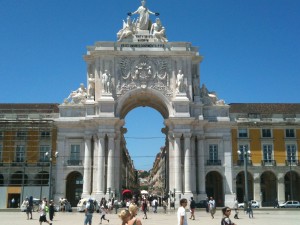 My pilgrimage started at the grand maritime entrance to Lisbon (Praca do Comercio) where, in 1493, a person could spend the entire day without hearing anyone speak the native language. Such was its importance in trade. Columbus announced the discovery of his first voyage, in February 1493, first in Lisbon and news of the discovery spread throughout Europe from Praca do Comercio. Columbus had strong ties to Lisbon.
My pilgrimage started at the grand maritime entrance to Lisbon (Praca do Comercio) where, in 1493, a person could spend the entire day without hearing anyone speak the native language. Such was its importance in trade. Columbus announced the discovery of his first voyage, in February 1493, first in Lisbon and news of the discovery spread throughout Europe from Praca do Comercio. Columbus had strong ties to Lisbon.
Lisbon had a large Italian population from Geneva when Columbus lived and worked there as a cartographer with his brother. He later was given a library from his wife’s father. Portuguese was the language of navigation while Columbus was alive and when it was time for him to learn to read (at age 25) he excelled in reading navigation books. It was clear to any who could read that the world was round and hence it is useful to ponder why the myth of a flat world was held so dear.
Need to Know Knowledge Sharing supported Flat world Myth
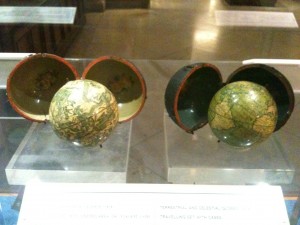 In 1492, a crusade had just ended in Europe, which was recovering from loss of life owing to war and plague. Coastal populations in Portugal struggled with Barbary Coast pirates who gathered slaves from those populations for trade in Arabia and for ransom. Venetian merchants held a monopoly on trade with India and China because they were willing to work with Moors and were ruthless in protecting the routes over land. Knowledge of these routes was worthless without consent from the Venetians because anyone attempting such land based trade would be executed unless permission had been given. It was a strong monopoly.
In 1492, a crusade had just ended in Europe, which was recovering from loss of life owing to war and plague. Coastal populations in Portugal struggled with Barbary Coast pirates who gathered slaves from those populations for trade in Arabia and for ransom. Venetian merchants held a monopoly on trade with India and China because they were willing to work with Moors and were ruthless in protecting the routes over land. Knowledge of these routes was worthless without consent from the Venetians because anyone attempting such land based trade would be executed unless permission had been given. It was a strong monopoly.
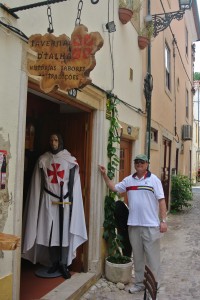 The Military Order of Christ (successor to the Knights Templar in Portugal) knew that a sea trade with India and China was possible by following the coast of Africa. Their Grand Master (today known as Prince Henry the Navigator) spent 40 years and considerable Order of Christ wealth in trying to break the Venetian monopoly. Rumors such as the world being flat but also rumors involving the lost city of Atlantis and sea monsters helped the Venetians hold on to their monopoly. Half of the sailors Henry sponsored died on expeditions so, even without rumors the risk was high and reward not certain until 1445 when numerous captives could be obtained past Cape Bojador.
The Military Order of Christ (successor to the Knights Templar in Portugal) knew that a sea trade with India and China was possible by following the coast of Africa. Their Grand Master (today known as Prince Henry the Navigator) spent 40 years and considerable Order of Christ wealth in trying to break the Venetian monopoly. Rumors such as the world being flat but also rumors involving the lost city of Atlantis and sea monsters helped the Venetians hold on to their monopoly. Half of the sailors Henry sponsored died on expeditions so, even without rumors the risk was high and reward not certain until 1445 when numerous captives could be obtained past Cape Bojador.
The Importance of Libraries
Prince Henry, by agreement with his older brother Pedro (who was regent to the child-king Alonso V), received a charter for one-fifth share of all profits from African voyages that normally went to the crown. Substantial profits from the slave trade financed further day trips down the African coast. With the opening of the first slave market in Europe in Lagos Portugal, traders found it profitable to lease the charter from Henry until Prince Henry’s death in 1460.
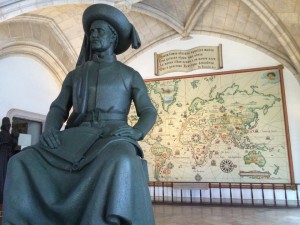 Columbus was a boy about 10 years old when Henry died but he had already begun work as a sailor out of Genoa, Italy on vessels that visited Lisbon, England, and Flanders. During one attempted visit, in 1476, his vessel (part of a 5-boat convoy) was mistakenly identified as a Barbary Coast or other enemy vessel and was destroyed by Portuguese defenders. Columbus survived by swimming to the site in Sangres where Henry the Navigator is credited with having founded a school for navigation. Columbus considered this his lucky career break, quickly making Lisbon (where a large Genoese colony was established and his brother worked as a map maker) and then, after marriage, Madeira his home. His first child was born in Porto Santo of the Madeira Islands which is 600 miles off the coast of Portugal. You can visit what is claimed to be the Columbus home today at Porto Santo. His wife’s father, Captain Bartolomue Perestrello , the governor of Madeira, had passed away when Christopher Columbus married and his mother in law gave Columbus the Captain’s library. When his wife died (five years after their son was born in 1485) Columbus focused on financing a voyage across the Atlantic. In most ways Columbus was at this time Portuguese and not Italian.
Columbus was a boy about 10 years old when Henry died but he had already begun work as a sailor out of Genoa, Italy on vessels that visited Lisbon, England, and Flanders. During one attempted visit, in 1476, his vessel (part of a 5-boat convoy) was mistakenly identified as a Barbary Coast or other enemy vessel and was destroyed by Portuguese defenders. Columbus survived by swimming to the site in Sangres where Henry the Navigator is credited with having founded a school for navigation. Columbus considered this his lucky career break, quickly making Lisbon (where a large Genoese colony was established and his brother worked as a map maker) and then, after marriage, Madeira his home. His first child was born in Porto Santo of the Madeira Islands which is 600 miles off the coast of Portugal. You can visit what is claimed to be the Columbus home today at Porto Santo. His wife’s father, Captain Bartolomue Perestrello , the governor of Madeira, had passed away when Christopher Columbus married and his mother in law gave Columbus the Captain’s library. When his wife died (five years after their son was born in 1485) Columbus focused on financing a voyage across the Atlantic. In most ways Columbus was at this time Portuguese and not Italian.
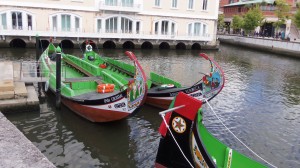 Portuguese focus on breaking the Venetian monopoly, lost after Prince Henry’s death, was renewed by the time Columbus pitched his voyage to the King of Portugal (Prince Henry’s grand nephew.) The king was not interested in such a voyage because of knowledge that breaking the monopoly was possible simply by continuing the focused day trips Prince Henry had supported down the African coast. Each explorer was required to plant stone markers, called padroes. And by contract, a padro had to be placed beyond all predecessors. It would be just a matter of time until markers extended to India and beyond. Columbus pitched his proposal many times to King Joao and to others eventually finding – after six years of rejection – acceptance by Queen Isabella of Spain, some think owing to the two both having red hair in common, but others believing that promise of new lands to be given to Military Order of Christ members, of which Columbus was one, were needed now that a crusade in Europe had ended. Without this promise of new lands, squabbling among young nobles who expected the crown to pay them in land was likely. Spain needed to search for suitable land and Columbus, unknowingly, had stumbled on the solution. The Keeper of the Privy Purse for King Ferdinand, Luis de Santangel, a cultivated friend of Columbus’, was able to secure financing for the venture using that solution as a main goal.
Portuguese focus on breaking the Venetian monopoly, lost after Prince Henry’s death, was renewed by the time Columbus pitched his voyage to the King of Portugal (Prince Henry’s grand nephew.) The king was not interested in such a voyage because of knowledge that breaking the monopoly was possible simply by continuing the focused day trips Prince Henry had supported down the African coast. Each explorer was required to plant stone markers, called padroes. And by contract, a padro had to be placed beyond all predecessors. It would be just a matter of time until markers extended to India and beyond. Columbus pitched his proposal many times to King Joao and to others eventually finding – after six years of rejection – acceptance by Queen Isabella of Spain, some think owing to the two both having red hair in common, but others believing that promise of new lands to be given to Military Order of Christ members, of which Columbus was one, were needed now that a crusade in Europe had ended. Without this promise of new lands, squabbling among young nobles who expected the crown to pay them in land was likely. Spain needed to search for suitable land and Columbus, unknowingly, had stumbled on the solution. The Keeper of the Privy Purse for King Ferdinand, Luis de Santangel, a cultivated friend of Columbus’, was able to secure financing for the venture using that solution as a main goal.
Scuttlebutt
The Pinzon brothers accompanied Christopher Columbus on his first Atlantic crossing. Columbus documented concerns regarding Alonso Pinzon because Alonzo Pinzon preferred to sail the Pinta at hull speed, racing ahead of the Santa Maria, a bulky trading ship that Columbus sailed on with Juan de la Cosa serving as Captain. When the Santa Maria was lost on a reef, the Pinta was absent and it was Yanez Pinzon on Nina that calmed the panic by encouraging the Santa Maria crew as well as Captain Cosa to follow Christopher Columbus. Captain Cosa had put the least experienced crew member at the helm of The Santa Maria when she went aground and was lost on Christmas Day 1492. As Captain, this was his right. However, Columbus had warned him against doing so. When Santa Maria crew members were safe ashore Columbus founded fort Navidad and gathered timbers from the wreck for its fortification. On January 4th 1493 he joined Yanez Pinzon on Nina, caught up with Alonso Pinzon on the Pinta, and allowed himself to be convinced that insolence and disloyalty were not involved. A homeward passage then commenced with the understanding that both vessels would stay within sight of each other and use flares at night to make that possible. 39 men were left at fort Navidad. The passage home was eventful.
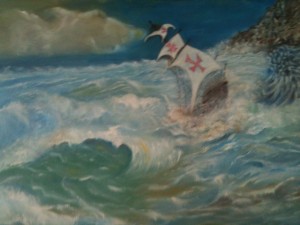 Owing possibly to storm, the Nina and Pinta were again separated and both assumed the other had been lost. Both required repairs (Nina in Lisbon and Pinto in Vigo Spain) before returning to home port in Palos Spain on the same tide. The Nina had arrived first and Alonzo Pinzon had nothing to look forward to but inevitable charges of insubordination. He died within the month but not before disseminating some rumors about Columbus wanting to abandon the Atlantic crossing before sighting land. His brother Yanez would not support the rumors. It is likely that Columbus, by disseminating his story from Lisbon earlier, limited damage that may have been caused by Alonso Pinzon and those loyal to him. Columbus’ instance that the Nina and Pinta arrive together was supportive of a unified communication regarding his findings.
Owing possibly to storm, the Nina and Pinta were again separated and both assumed the other had been lost. Both required repairs (Nina in Lisbon and Pinto in Vigo Spain) before returning to home port in Palos Spain on the same tide. The Nina had arrived first and Alonzo Pinzon had nothing to look forward to but inevitable charges of insubordination. He died within the month but not before disseminating some rumors about Columbus wanting to abandon the Atlantic crossing before sighting land. His brother Yanez would not support the rumors. It is likely that Columbus, by disseminating his story from Lisbon earlier, limited damage that may have been caused by Alonso Pinzon and those loyal to him. Columbus’ instance that the Nina and Pinta arrive together was supportive of a unified communication regarding his findings.
According to 16th-century Spanish chronicler Francisco Lopez de Gomera, Columbus’ first voyage was the “greatest event since the creation of the world (excluding the incarnation and death of Him who created it).” But his subsequent voyages were worse than unsuccessful. None of the 39 left at Fort Navidad were found alive when Columbus returned later that year. They had all been killed by Indians. The following decade turned Columbus from an optimistic and talented entrepreneur to a pessimist obsessed with the idea that enemies were everywhere. He suffered from severe arthritis and died on May 20 1506.
Portuguese Maritime Museum
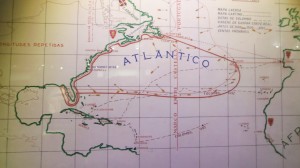
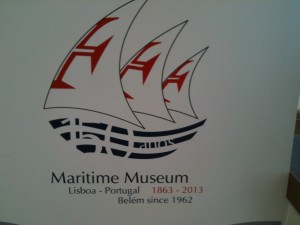 I continued my pilgrimage at the Portuguese Maritime Museum. Tales of the sea, of men and civilization were oriented to the Portuguese citizen and a portrait of Christopher Columbus (who as described above was for at least a while Portuguese) was on display as was a chart depicting his Atlantic Crossings. In 1565, Italian chronicler Girolamo Benzoni wrote in his History of the New World that if Columbus had “lived in the time of the Greeks or of the Romans or any other liberal nation they would have erected a statue.” In lieu of a statue, artists created paintings from descriptions of Columbus. None were done when he was alive. These paintings were very popular in the late 16th century. There were hundreds of different depictions of his image. The one at the Museum showed a man with blond and not reddish hair but I was please to see it. There is a world chart near the statue of Henry the Navigator which holds center stage at the museum. The chart shows the paths of the great Portuguese explorers but did not include Columbus’ four Atlantic crossings. Columbus sailed for Spain but so did Ferdinand Magellan who proved Columbus’ was correct, that it was possible to sail around the world to the source of wealth for the Venetian monopoly. Note that Columbus had known of the Pacific Ocean from reports during his forth voyage to Panama and that Magellan died before completing Columbus’ quest to reach India.
I continued my pilgrimage at the Portuguese Maritime Museum. Tales of the sea, of men and civilization were oriented to the Portuguese citizen and a portrait of Christopher Columbus (who as described above was for at least a while Portuguese) was on display as was a chart depicting his Atlantic Crossings. In 1565, Italian chronicler Girolamo Benzoni wrote in his History of the New World that if Columbus had “lived in the time of the Greeks or of the Romans or any other liberal nation they would have erected a statue.” In lieu of a statue, artists created paintings from descriptions of Columbus. None were done when he was alive. These paintings were very popular in the late 16th century. There were hundreds of different depictions of his image. The one at the Museum showed a man with blond and not reddish hair but I was please to see it. There is a world chart near the statue of Henry the Navigator which holds center stage at the museum. The chart shows the paths of the great Portuguese explorers but did not include Columbus’ four Atlantic crossings. Columbus sailed for Spain but so did Ferdinand Magellan who proved Columbus’ was correct, that it was possible to sail around the world to the source of wealth for the Venetian monopoly. Note that Columbus had known of the Pacific Ocean from reports during his forth voyage to Panama and that Magellan died before completing Columbus’ quest to reach India.
If Spain is the head of Europe, Portugal, where land ends and sea begins, is the crown upon the head” sang Luis de Camoes, Portugal’s great national poet in 1572.
There is more about Portugal Pilgrimages to come.



13 thoughts on “Lisbon Stop Over”